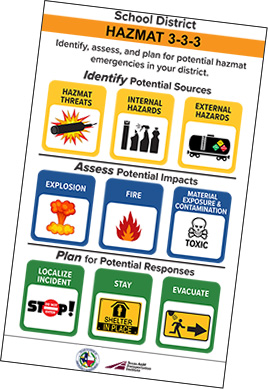Hazardous materials (hazmat) travel daily by road, rail, pipeline, waterway and air through the Lone Star State. Most transport vehicles safely arrive with their cargo. It’s when things go wrong — such as a hazmat incident or train derailment near a school — that a well-informed, thorough safety plan can save student, teacher and staff lives.

Texas Education Code Section 37.108 mandates that school districts with facilities within 1,000 yards of rail tracks have a train derailment policy in their emergency plans. Texas A&M Transportation Institute (TTI) researchers recently developed the Hazardous Materials and Train Derailment Emergency Planning Guide for School Districts and Community Colleges. It was funded by the Hazardous Materials Emergency Preparedness Grant under the U.S. Department of Transportation’s Pipeline and Hazardous Materials Safety Administration and administered by the Texas Division of Emergency Management. The guide supplements emergency planning standards and protocols published by the Texas State School Safety Center.
The purpose of the guide is to provide resources and tools that school district administrators, emergency managers and safety officers can use to be proactive about planning for hazmat and train derailment emergencies. The TTI research team interviewed district administrators and safety personnel from across Texas and reviewed literature, guidance and data on lessons learned in disaster management.
“Our research found that many school districts lack resources for hazmat and train derailment emergency planning,” says Brad Trefz, lead author and TTI associate transportation researcher. “The guide provides tools and best practices that school districts can use to improve their readiness across the full spectrum of hazmat incidents.”

Andrew Christjoy, doctoral student in Texas A&M University’s Department of Communication and former TTI research associate, explains, “The interviews helped us create a unified, comprehensive guide with information that can be immediately applied by emergency managers in any Texas school district.”
The team organized the guide into the following documents:
- Summary for Planning Leaders, with an introduction to the guide and why planning for safety in these situations is important;
- Volume 1, which outlines an emergency management and planning framework;
- Volume 2, with recommendations to make hazmat incident prevention, protection, response, recovery and mitigation part of school emergency plans;
- Volume 3, which walks school districts through steps for hazmat threat and hazard risk assessments; and
- Volume 4, which offers emergency plan templates that align with plans used by emergency responders in most Texas communities.
Based on insights from the interviews and literature review, the team developed several new ideas and tools that districts can use to enhance their emergency plans. “We start with what school districts already know and do, and build from there,” says Dr. David Bierling, project director, TTI research scientist and director for transportation research at Texas A&M’s Hazard Reduction and Recovery Center. “For example, many school districts already practice evacuating for fire or active shooter emergencies, but evacuating for a major external hazmat emergency can be very different, and schools need to plan and practice for that as well.”
The guide also presents a new hazmat 3-3-3 planning model to help identify internal threats, internal hazards or external hazards that could lead to an explosion, fire or toxic release. Appropriate responses involve localizing and isolating an incident, sheltering in place, or evacuating to a safe area. When things go wrong and warnings bells ring, being prepared can protect people on a school’s campus.
“TTI’s efforts to assist K–12 school systems in this area represent a significant leap forward in terms of collaboration by multiple agencies to offer technical emergency planning resources that will save lives,” notes Jon Bodie, emergency management director for the Frisco Independent School District and a certified Texas emergency manager. “I’m sincerely grateful for the opportunity to have participated in this important TTI readiness initiative, and I’m looking forward to integrating TTI’s content into our district and campus emergency plans and related training regimens.”
